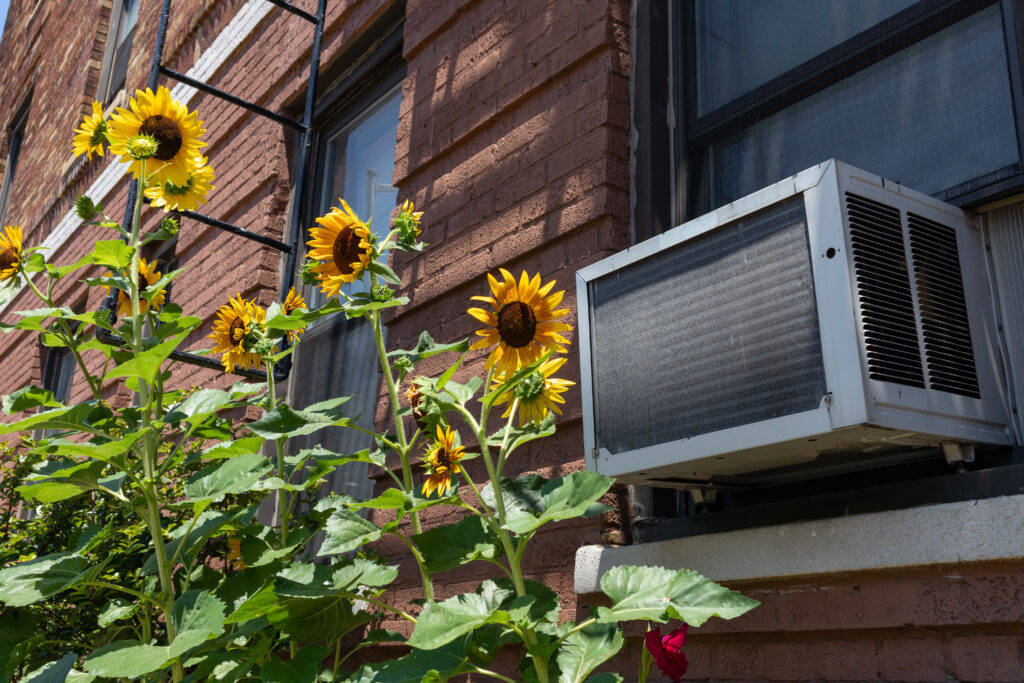How to Remove Mold From Window AC

Air conditioners keep your home comfortable, but they can be a breeding ground for mold growth because they require moisture to run. If your home feels comfortable but smells terrible, you may have mold in your window AC.
Not only does mold smell bad, but it can cause serious health problems. This is especially true if you suffer from chronic respiratory issues or have allergies.
Because the AC unit circulates air throughout the room, it spreads mold spores each time it turns on. The spores can grow if they land in the right spot, such as carpet, furniture, and even walls. All it takes is a dark, damp area, and the spores have a party, multiplying faster than you can count.
If you think you have window AC mold, knowing how to safely remove it and when to call a professional is important.
Table of Contents
Understanding the Dangers of Mold in Window Units
Sometimes, you can visibly see mold growing. It usually shows up as green or black fuzzy spots. But by the time you can see the mold, it has been present and spread significantly. The most common type of mold is black mold, or tachybotrys chartarum (S. chartarum). This is the mold on your home’s drywall or other wood products.
However, not all mold is as visible as black mold. Your window AC may also form other types of mold, such as fusarium or acremonium. Fusarium is a pink mold that can cause skin infections and allergic reactions. If you’re exposed for extended periods, it can also cause more serious infections.
Acremonium is a common mold in air conditioners and is very toxic. When visible, it has a powdery texture that’s pink or grey. It can cause immune problems in the immuno-compromised and cause full-body infections if not caught early.
Signs Your Window AC Has Mold
Mold isn’t always visible, so it’s important to know the telltale signs, including the following:
- Musty odor each time the unit turns on
- Black dust on the AC’s vents
- Visible signs of mold on the filter
- Sudden onset of respiratory issues or skin irritation
Preparing to Remove Mold from Your Window AC Unit
Removing window AC mold isn’t something to take lightly. If you plan to handle the issue yourself, understand the necessary safety precautions and supplies needed.
Safety Precautions
Always have the necessary safety gear so you don’t touch or breathe in the mold spores, and only work on the unit in an area with proper ventilation or outdoors. The protective gear needed includes gloves, an N-95 mask, and goggles. Never deal with mold without these safety precautions.
Necessary Supplies
To clean the mold, you’ll need several supplies, including the following:
- Mold cleaners, such as CLR or your chosen product
- Shop-vac or vacuum you don’t use around your house
- Bucket of warm water and soap
- Clean scrub brush
- Clean cloth
Step-by-Step Direction for Removing Mold
Removing mold yourself should be handled cautiously and only with the help of another person, with both people wearing proper protection. Once you’ve put on your safety gear, take the following steps:
Step 1: Turn the AC off and unplug it
Don’t touch the AC unit until you’re sure it’s off and unplugged. This is for everyone’s safety while you remove the mold.
Step 2: Remove the AC unit from the window
Working on the AC unit outdoors on a back patio or open garage is best. If you must work on it indoors, put it in an isolated room with adequate ventilation.
Step 3: Disassemble the unit
Remove the AC’s front grill. This will expose the filter, which you will remove in the next step. You may need a screwdriver if the grill doesn’t just pull off.
Step 4: Clean the filter
Determine if you have a disposable or reusable filter. If it’s disposable, toss the existing filter and install a new one. If it’s reusable, wash the existing filter in a bucket with warm water and soap. You can use dish soap or any other gentle soap. Before placing the filter in the water, spray it with CLR or another mold remover and let it sit in the water for 15 minutes.
Step 5: Clean the interior components
While the filter soaks, remove the back of the AC unit and use your shop vac to remove any excess dirt or dust. If you see any visible mold, spray a rag with mold cleaner and try to clean the area, but be sure you are wearing gloves.
Step 6: Scrub the Unit
Inspect the entire AC unit and spray any areas you find with mold cleaner, letting it sit for ten minutes, and then scrub it.
Step 7: Rinse and dry
After spraying and scrubbing the AC unit, let it completely dry. If you have any remaining residue, rinse it first, then let it try.
Step 8: Reassemble the unit
Don’t reassemble the AC unit until you’re sure it’s dry. The moisture will only create another breeding ground for mold.
Preventative Measures to Take
To avoid mold growth in the first place, consider these tips.
Regular Cleaning and Maintenance
Change your AC filter monthly, and wipe down any exposed areas often. If you notice a musty smell, act fast. Mold spores can multiply in 24 hours, creating a messier problem. Staying up-to-date with the AC unit’s cleanliness can prevent this. Dust is a food source for mold, so the less dust there is, the less chance of mold growth.
Control Humidity Levels
Indoor humidity creates a viable environment for mold. To reduce the risk of mold in your window AC, use a dehumidifier to reduce the humidity in the room or purchase an AC with humidity control. Also, ensure the AC unit properly drains. If the dark, damp area houses excessive moisture, mold spores can quickly grow.
Use Auto Mode
Don’t let your AC unit sit idle while you are away from home. Moisture buildup and lack of airflow can lead to mold growth. Instead, let the system run automatically to keep the moisture moving and reduce the risk of mold.
Conclusion
Knowing how to clean a window AC unit with mold is important since mold can easily grow on them. The key is catching the mold early and taking care of it. Moving forward, keep the unit as clean as possible, change the filter often, and control the room’s humidity to reduce the risk of mold growth.
If you aren’t sure if mold is the problem but your AC doesn’t run properly, consider calling an HVAC professional near you to determine the cause.

Request Service
Get started by filling out a request form or by giving us a call.
FAQs
What temperature should I set my air conditioner to prevent mold?
Seventy-eight degrees is often the ‘sweet spot’ for preventing mold. Avoid keeping the AC set above 80 degrees because humidity remains in the room at that temperature, which can cause mold to grow. However, if you want it cooler, you can set it to a lower temperature.
Can running the AC too cold cause mold?
If your AC runs too cold and your room has a lot of humidity, the moisture the cold temperature creates can cause mold to grow. Determining how to control the humidity while keeping the room comfortable is important.
How do I clean a window air conditioner without removing it?
You can clean a window air conditioner, leaving it in its place, but first, unplug the unit from the wall and turn it off. Disassemble the AC unit as best you can, and scrub all components to remove mold and dust to keep the system in good condition.
Check Out Additional HVAC Resources
- Guide to HVAC Hard Start Kits
- Guide to Furnace Installation
- Ductless Mini Splits vs Central AC
- MERV 8 vs Merv 11 vs Merv 13: Which is Best?
- How to Clean a Clogged AC Drain Line
Sources:

Anna has over six years of experience in the home services and journalism industries and serves as the Content Manager at MyHomePros.com, specializing in making complex home improvement topics like HVAC, roofing, and plumbing accessible to all. With a bachelor’s degree in journalism from Auburn University, she excels in crafting localized, comprehensive guides that cater to homeowners’ unique needs. Living on both coasts of the United States has equipped her with a distinctive perspective, fueling her passion for turning any house into a cherished home through informed, personalized decision-making.

 888-524-2244
888-524-2244






